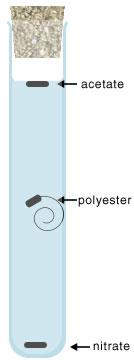Film
Motion picture film is inherently unstable, consisting of many different and complex layers. Black and white film has four to five layers: a gelatin layer to protect the image against abrasion, the image layer of light-sensitive emulsion consisting of silver salts in gelatin, an adhesive layer that binds the image to the support, the support made from acetyl-cellulose (before 1951 supports could be made from nitrocellulose or nitrate), and generally another coating of gelatin as a dimensional stabilizer.
Color film is much more complex. It consists of nine layers: the gelatin layer to prevent abrasion, blue-sensitive gelatin with silver salts and color couplers, a yellow filter that allows the passage of green and red rays but absorbs any blue rays not absorbed by the blue layer, a green-sensitive layer, a gelatin layer to prevent dye migration, a red-sensitive layer, an adhesive binding layer, the support made from cellulose triacetate or polyester, and a gelatin dimensional stabilizer.
Identification
Before the early 1950s all 35-millimeter film was produced on nitrate base or support, although acetate or polyester was used for 8-, 16-, and 70-millimeter film. Because nitrate film is very unstable, it should be identified and appropriate steps taken to segregate it from other types of film.
Nitrate deteriorates in a way that is dangerous to other materials. In some instances motion picture film has burst into flames at temperatures above 40 degrees Celsius. Nitrate film has five stages of deterioration:
An acidic odor comes from the film, the silver image starts to fade, and the color of the emulsion changes to amber or brown.
The acidic odor becomes more pronounced, and the emulsion becomes sticky, with the result that negative layers adhere together and to their container.
The acidic odor strengthens, and portions of the film become soft, with bubbles forming.
The film continues to soften and congeals into a solid lump, sometimes with a froth.
The solid lump collapses into a strong smelling powder.
Cellulose acetate, or “safety” film, was manufactured in response to concerns about the inherent instability of cellulose nitrate. Used mainly for 16-millimeter film after about 1923, cellulose acetate is made from various forms of cellulose fiber combined with acetic acid, acetic anhydride, and, as a catalyst, sulfuric acid. Cellulose diacetate was first made by Kodak, from 1925 to 1940, and Agfa continued to make it until 1955. Cellulose triacetate, more durable than diacetate, gradually replaced it in the late 1940s. Most commercial motion picture film is still produced on triacetate.
Polyester-based film is strong, flexible, and durable and is not dimensionally reactive to changes in temperature and relative humidity. The emulsion layer is composed of gelatin, which is more vulnerable to change than the polyester base as it is hygroscopic and can mold in conditions of high relative humidity.
Diagnostic Tests
It is important to differentiate between one form of motion picture film and another, especially before deterioration begins. Nitrate negatives are difficult to distinguish from acetate and polyester film, although there are some useful clues. Cellulose acetate film generally has the word “safety” stamped on the edge of the film, and polyester film often has the word “ESTAR.” The date of the film is also an important clue. In addition, two basic tests can be conducted: the flotation test and the burn test, both of which should only be conducted with appropriate personal safety equipment and in ventilated spaces.
The flotation test measures the relative densities of the three main types of film using a small sample cut or punched out of a transparent area of the film. One of two solutions is mixed in a test tube: 43 centiliters (cc) of trichloroethylene and 25 cc of  trichloroethane, or 10 cc of Kodak Film Cleaner and 40 cc of trichloroethylene. The small samples of film are placed in the solution, and the test tube is sealed and inverted three to four times.
trichloroethane, or 10 cc of Kodak Film Cleaner and 40 cc of trichloroethylene. The small samples of film are placed in the solution, and the test tube is sealed and inverted three to four times.
The sample of modern acetate film will float to the surface within 10 seconds. Polyester film will remain suspended in the solution, neither floating to the surface nor sinking to the bottom. Nitrate film will immediately sink to the bottom. Sometimes older acetate film will behave like polyester and remain suspended. Because the test uses volatile solvents, it should be performed in a well-ventilated area.
The burn test must be conducted in a well-ventilated area completely separate from the film storage area and in a carefully controlled environment. A small cut sample of the film is ignited. Nitrate film will immediately ignite and cannot be extinguished until it is completely burned away. Cellulose acetate film will ignite and burn with great difficulty and will not flame up. Polyester film will similarly be very difficult to ignite and does not burn easily.
For more information on motion picture film, see Resources at the end of this tutorial.